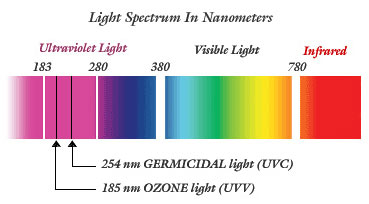Scientific Data
We utilize Scientifically proven 03 and Ultraviolet Technologies
Germicidal UV Energy (UVC) 254 nanometer
Ultraviolet (UV) energy from the sun is used in nature to help cleanse outdoor air and to inhibit the growth of micro-organisms such as germs and bacteria, UV Germicidal lights have been used indoors for many years as a trusted air purifying method in hospitals, labs, schools, nursing homes, office buildings, other commercial environments and residences worldwide.
Your furnace provides a perfect environment for the growth of broadcast germs, mold, bacteria, toxins and gases that can cause unhealthy air conditions and lead to health issues. Your furnace is the collection point for re-circulating air in y our home and is the ideal location to install a whole home indoor air purification unit.
Airborne pathogens—(micro-organisms) are the cause of infectious diseases along with bacteria, viruses, fungi, mold, and mildew. Chronic rhinitis, asthma and other respiratory ailments are conditions caused by poor indoor air quality. Mold spores and germs are the most common bioaerosols and pathogens. Other indoor air pollution includes volatile organic compounds also referred to as VOC’s. These VOC’s product toxic gasses (some have a detectible odor and others do not) that cause allergies and other health problems. We are not as effected by these toxic compounds present in our outdoor environment because the UV light produced naturally from the sun helps to destroy them.
Ultraviolet Energy and Ozone (UVV) 185 nanometer
Ozone is naturally produced by the process of sunlight on the oxygen molecules. This photochemical process is known as the “solar photosis”. Sunlight breaks down some of the oxygen molecules to make ozone. Ozone is created by the high electrical discharge of lightning.
Ultraviolet (UV) energy from the sun is used in nature to help cleanse outdoor air and to inhibit the growth of micro-organisms such as germs and bacteria, UV Germicidal lights have been used indoors for many years as a trusted air purifying method in hospitals, labs, schools, nursing homes, office buildings, other commercial environments and residences worldwide.
Your furnace provides a perfect environment for the growth of broadcast germs, mold, bacteria, toxins and gases that can cause unhealthy air conditions and lead to health issues. Your furnace is the collection point for re-circulating air in y our home and is the ideal location to install a whole home indoor air purification unit.
Airborne pathogens—(micro-organisms) are the cause of infectious diseases along with bacteria, viruses, fungi, mold, and mildew. Chronic rhinitis, asthma and other respiratory ailments are conditions caused by poor indoor air quality. Mold spores and germs are the most common bioaerosols and pathogens. Other indoor air pollution includes volatile organic compounds also referred to as VOC’s. These VOC’s product toxic gasses (some have a detectible odor and others do not) that cause allergies and other health problems. We are not as effected by these toxic compounds present in our outdoor environment because the UV light produced naturally from the sun helps to destroy them.
This triatomic form (03) of oxygen is formed naturally in the upper atmosphere by a photochemical reaction with solar ultraviolet radiation. Ozone in the upper atmosphere (Ozone Layer) absorbs much of the suns intense UV radiation, thus protecting the earth from these damaging rays. Ozone is also measured in trace amounts in the lower atmosphere of the earth and is natures ways of oxidizing toxic gasses and eventually breaking them down into harmless components molecules.
The benefits of UV energy and ozone are not naturally present in our indoor air environment. Our indoor air is the perfect breeding ground for micro-organisms such as mold, bacteria, viruses and fungi. For the past thirty years construction guidelines have improved rendering our homes more energy efficient and less capable of allowing allergens, airborne particles, infectious agents, toxic compounds in carpeting, building materials and cleaning chemicals to escape.

